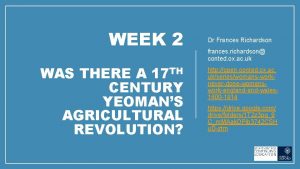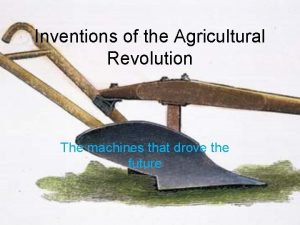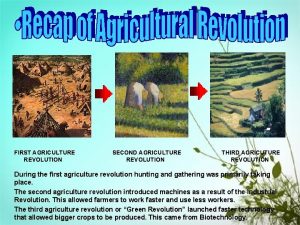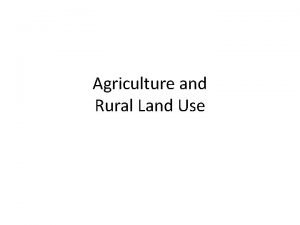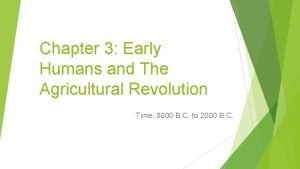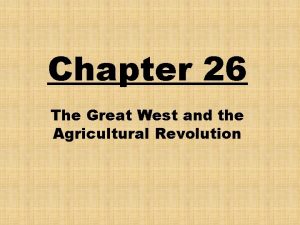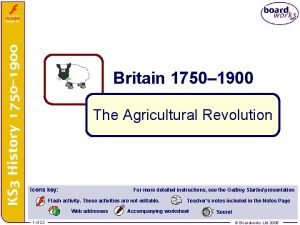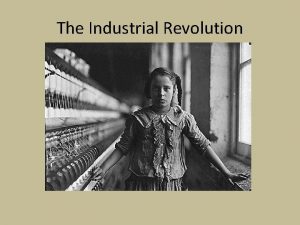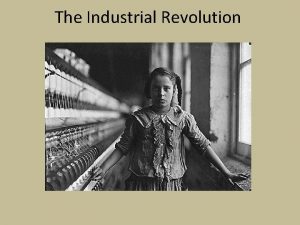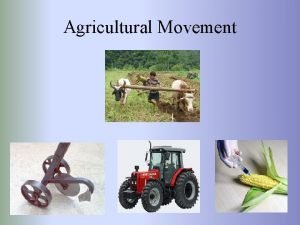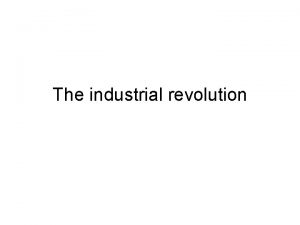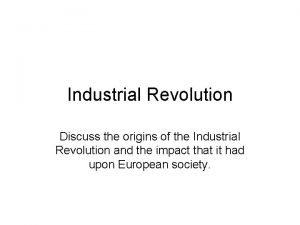The Industrial Revolution I English Origins Agricultural revolution










- Slides: 10

The Industrial Revolution

I. English Origins • Agricultural revolution led to increased food supply and a growth in … • population • Technological breakthroughs came from… • inventive citizens • Availability of resources including: • large coal supplies, • plenty of iron, and a • labor force • Government supported… • economic growth • Navy offered protection for: • merchant ships

• Rich landowners took over and fenced off land at the expense of… • peasant farmers • Larger farms increased: • output and… • profit • The larger fields required fewer… • workers • Displaced peasant farmers migrated to… • towns and… • cities • They formed the labor force needed to work in… • factories with new machines Enclosure Movement

• Crowded tenements • No sewage or sanitation systems • Disease spread rapidly • Noisy and smelly environment • Polluted air • High crime rates • Frequent abuse of alcohol • People were tired from long hours at work

Growing Middle Class • Upper middle class included doctors, lawyers, and scientists • Lower middle class included teachers, office workers, shop keepers, and clerks • Workers and peasants made up the lower class • Growth in education - 3 “R’s” • Emphasis on punctuality, obedience, discipline, patriotism, and religion • Roles of women: act proper, marry well, raise children, direct servants, religious or charitable work

Labor Unions • Working class became increasingly dissatisfied with working conditions • Protested low wages, long hours, unsafe conditions, and constant threat of unemployment • Germany legalized labor unions in 1869, followed soon after by Britain, Austria, France, etc. • Universal male suffrage in most western countries helped the cause of labor unions • Laws eventually passed to regulate working conditions to appease workers • Gains included old age pensions and disability insurance

New Economic Ideas • Capitalism • Laissez-Faire Economics • Socialism • Communism Adam Smith Frederick Engels Karl Marx

Capitalism • Adam Smith – led the battle cry for laissez-faire economics – a hands off approach • Free market – unregulated exchange of goods • According to Smith, a free market would eventually help everyone, not just the rich • More goods could be produced at lower costs making products more affordable for everyone • As a result, capitalists would be encouraged to reinvest their profits into new business enterprises

Socialism • A proposed solution to end poverty and injustice • People as a whole rather than private individuals would own and operate the means of production • Grew out of Enlightenment belief in progress and goodness of human nature • Society to operate for the benefit of all members, rather than just for the wealthy

Communism • Karl Marx believed that economics is the driving force in history • History of “class struggles” between the “haves” and the “have-nots” • He saw the modern class struggle that was going on during the industrial revolution as being between the bourgeoisie and the proletariat • Marx predicted that the proletariat would be victorious • They would set up a classless, communist society
 The third agricultural revolution
The third agricultural revolution The agricultural revolution
The agricultural revolution Agricultural revolution inventions
Agricultural revolution inventions Agricultural revolution
Agricultural revolution Green revolution ap human geography
Green revolution ap human geography 1 hectare size
1 hectare size Early humans and the agricultural revolution
Early humans and the agricultural revolution The rise of civilization lesson 2 the neolithic revolution
The rise of civilization lesson 2 the neolithic revolution Chapter 26 the great west and the agricultural revolution
Chapter 26 the great west and the agricultural revolution Cause and effects of the neolithic revolution
Cause and effects of the neolithic revolution Agricultural revolution worksheet
Agricultural revolution worksheet

